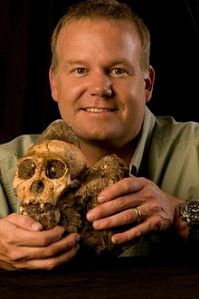How An Eagle Scout Unearthed One Epic Fossil

Professor Lee Berger has scoured the caves and savannahs of Africa for cool fossils and ancient artifacts. In 2008, Berger and his 9-year-old son discovered a fossil that rocked the scientific community, and this month he will speak about his love of nature at the 2013 National Scout Jamboree. I recently sat down with the Eagle Scout paleoanthropologist to talk exploration, investigation and the great outdoors.
BL: What first interested you in science?
L.B.: Like many boys I spent a significant amount of time in the woods, and this bred in me a tremendous appreciation for nature. I also was always collecting something. I started with collecting rocks, and in my early teens moved on to a passion for finding and collecting Native American artifacts.
BL: How did you earn your Eagle Scout Award?
L.B.: My Eagle project was the gopher tortoise conservation project, which not only gained me my Eagle, but also resulted in my being awarded the Georgia Youth Conservationist of the Year in 1984.
BL: What does a paleoanthropologist do?
L.B.: Paleoanthropology is the study of ancient humans and their beginnings. So I’m constantly on the hunt to discover, research and explore. I am always searching for incredible fossils, especially those of early humans and primates that can help us with the story of our origins.
BL: You’re speaking at the jamboree this summer. What will you talk about?
L.B.: The danger of losing our connectivity with the outdoors. I hope to encourage youth to get back out there. This is why I feel Scouting is more relevant and perhaps more important than ever in history.
BL: How can Scouts better connect with the outdoors?
L.B.: Technological advances have offered tremendous opportunity for discovery and exploration. But there is a great, unexplored planet out there, and it takes not only the desire to travel to remote places to make discoveries, but the skills to interact with the real world. Through its mission and programs, Scouting can re-engage us with the real world.
BL: How do you encourage young people interested in pursing a career in science?
L.B.: Find an area of science that you love and follow it. We need more explorers, people willing to go out and take risk and find things, knowing they might not. We need more young people with the recognition that there are still plenty of cool things to be found right in front of us. We just need to keep looking.
_____________________________________________________________________________
Want to learn more about Dr. Berger’s discovery?
In “The Skull In The Rock,” Dr. Berger describes how he and his son used Google Maps and hard work to uncover one of the most important fossils in history.
National Geographic, $18.95 hardcover.
Ages 9 and up.

Leave a Comment